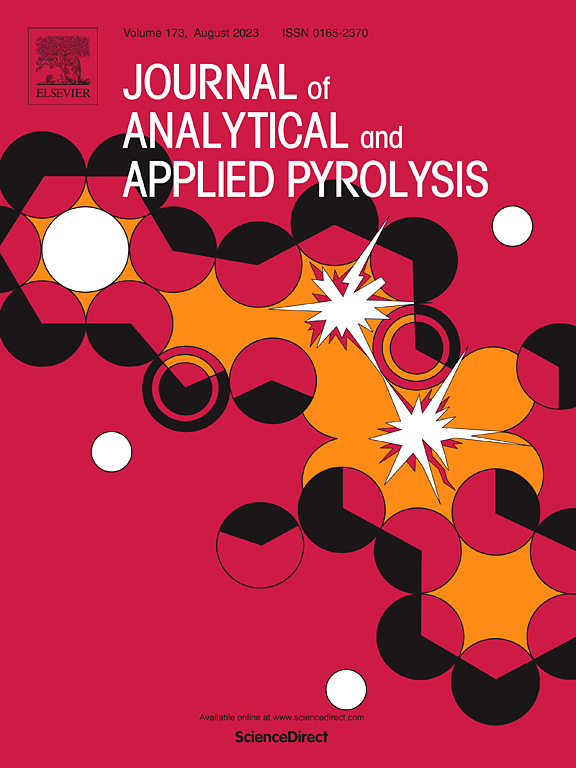The effect of the mineral matrix during thermal analysis of polymers: Implications for microplastics characterization
IF 6.2
2区 化学
Q1 CHEMISTRY, ANALYTICAL
引用次数: 0
Abstract
The exponential growth of global plastic production complicates waste management, leading to the accumulation of microplastics in the environment. Currently, the identification and quantification of microplastics rely on various analytical methods that often require sample pretreatments, which can introduce errors. The Rock-Eval® thermal method, through the total quantity of hydrocarbon (Total HC parameter) and the temperature of their maximum release (Tpeak), identifies and quantifies polymers when individually analyzed. However, mineral matrices in natural sediments can influence these parameters. In this study, synthetic mixtures of various mineral matrices and polymers were analyzed using the thermal Rock-Eval® method. Three effects of mineral matrices on the thermal degradation of polymers have been identified: (1) catalysis, which accelerates the polymer degradation;(2) multimodal inhibition, characterized by a fractionated release of hydrocarbons, first at expected pyrolysis temperatures and then at higher temperatures; and (3) retention, which reduces total HC released. The same mineral matrix can produce different effects depending on the type of polymer with which it is mixed. For instance, illite catalyzes the degradation of polyethylene (PE), but inhibits that of polyethylene terephthalate (PET). Despite these effects, linear regressions between the Total HC and polymer content in synthetic mixtures provide a coefficient of determination (r²) of 0.99, confirming that matrix effects do not hinder polymer quantification. Furthermore, mixtures with natural matrices show effects comparable to those observed with synthetic matrices. These findings represent a first step towards understanding the effects of the matrix and confirm the possibility of using the thermal Rock-Eval® method as a simple tool to identify and quantify microplastic pollution in natural sediments.
聚合物热分析过程中矿物基质的影响:对微塑料表征的影响
全球塑料生产的指数级增长使废物管理复杂化,导致微塑料在环境中积累。目前,微塑料的鉴定和定量依赖于各种分析方法,这些方法往往需要样品预处理,这可能会引入误差。Rock-Eval®热法通过碳氢化合物的总量(total HC参数)和最大释放温度(Tpeak),在单独分析时识别和量化聚合物。然而,天然沉积物中的矿物基质会影响这些参数。在这项研究中,使用热岩石- eval®方法分析了各种矿物基质和聚合物的合成混合物。矿物基质对聚合物热降解有三种影响:(1)催化作用,加速聚合物降解;(2)多模式抑制作用,以烃类分馏释放为特征,首先在预期热解温度下释放,然后在更高温度下释放;(3)滞留,减少总HC释放。相同的矿物基质可以产生不同的效果,这取决于与它混合的聚合物的类型。例如,伊利石催化聚乙烯(PE)的降解,但抑制聚对苯二甲酸乙二醇酯(PET)的降解。尽管存在这些影响,但合成混合物中总HC和聚合物含量之间的线性回归提供了0.99的决定系数(r²),证实基质效应不会阻碍聚合物的定量。此外,与天然基质的混合物显示出与合成基质相当的效果。这些发现代表了了解基质影响的第一步,并证实了使用热岩石评估®方法作为识别和量化天然沉积物中微塑料污染的简单工具的可能性。
本文章由计算机程序翻译,如有差异,请以英文原文为准。
求助全文
约1分钟内获得全文
求助全文
来源期刊
CiteScore
9.10
自引率
11.70%
发文量
340
审稿时长
44 days
期刊介绍:
The Journal of Analytical and Applied Pyrolysis (JAAP) is devoted to the publication of papers dealing with innovative applications of pyrolysis processes, the characterization of products related to pyrolysis reactions, and investigations of reaction mechanism. To be considered by JAAP, a manuscript should present significant progress in these topics. The novelty must be satisfactorily argued in the cover letter. A manuscript with a cover letter to the editor not addressing the novelty is likely to be rejected without review.

 求助内容:
求助内容: 应助结果提醒方式:
应助结果提醒方式:


